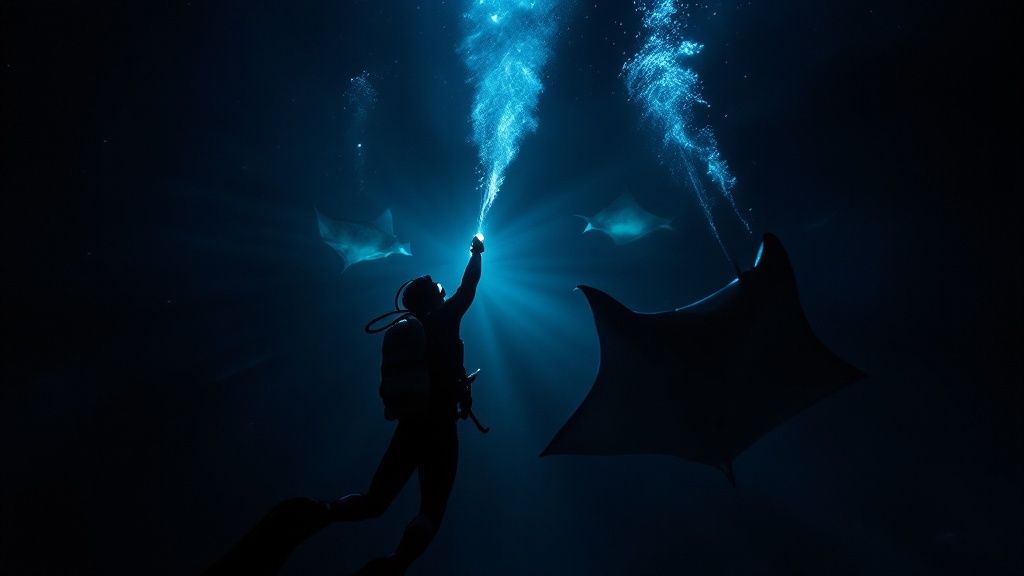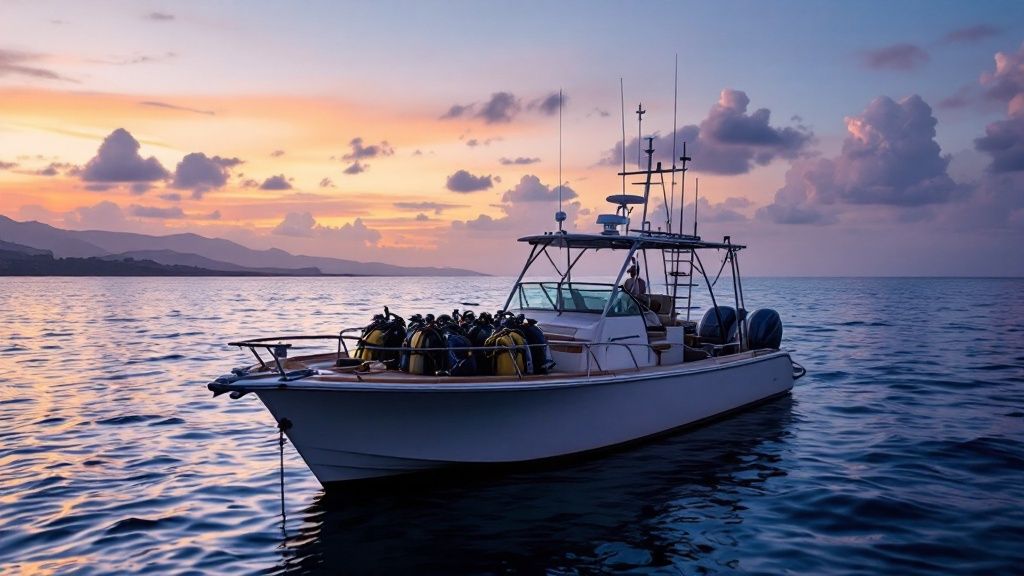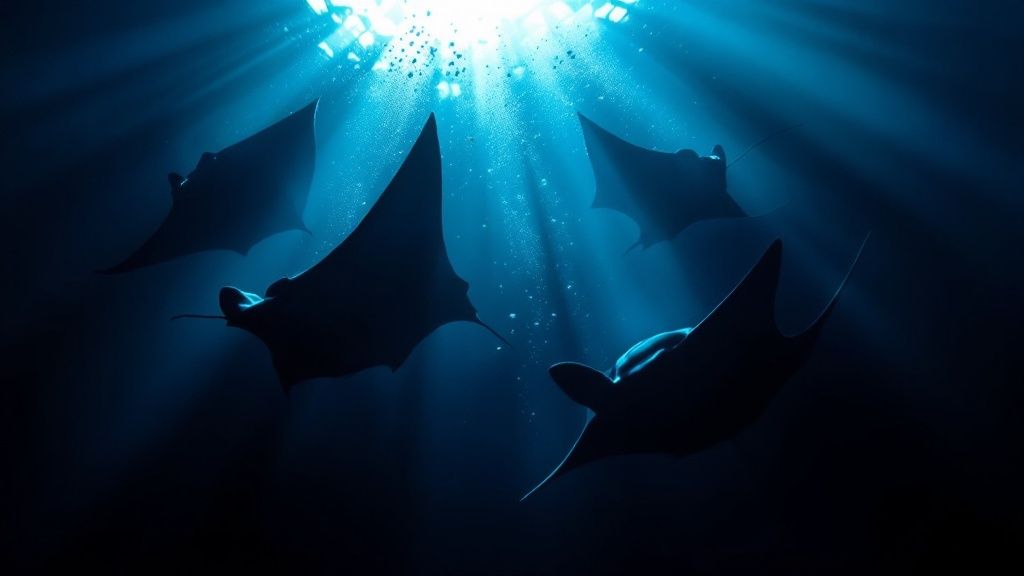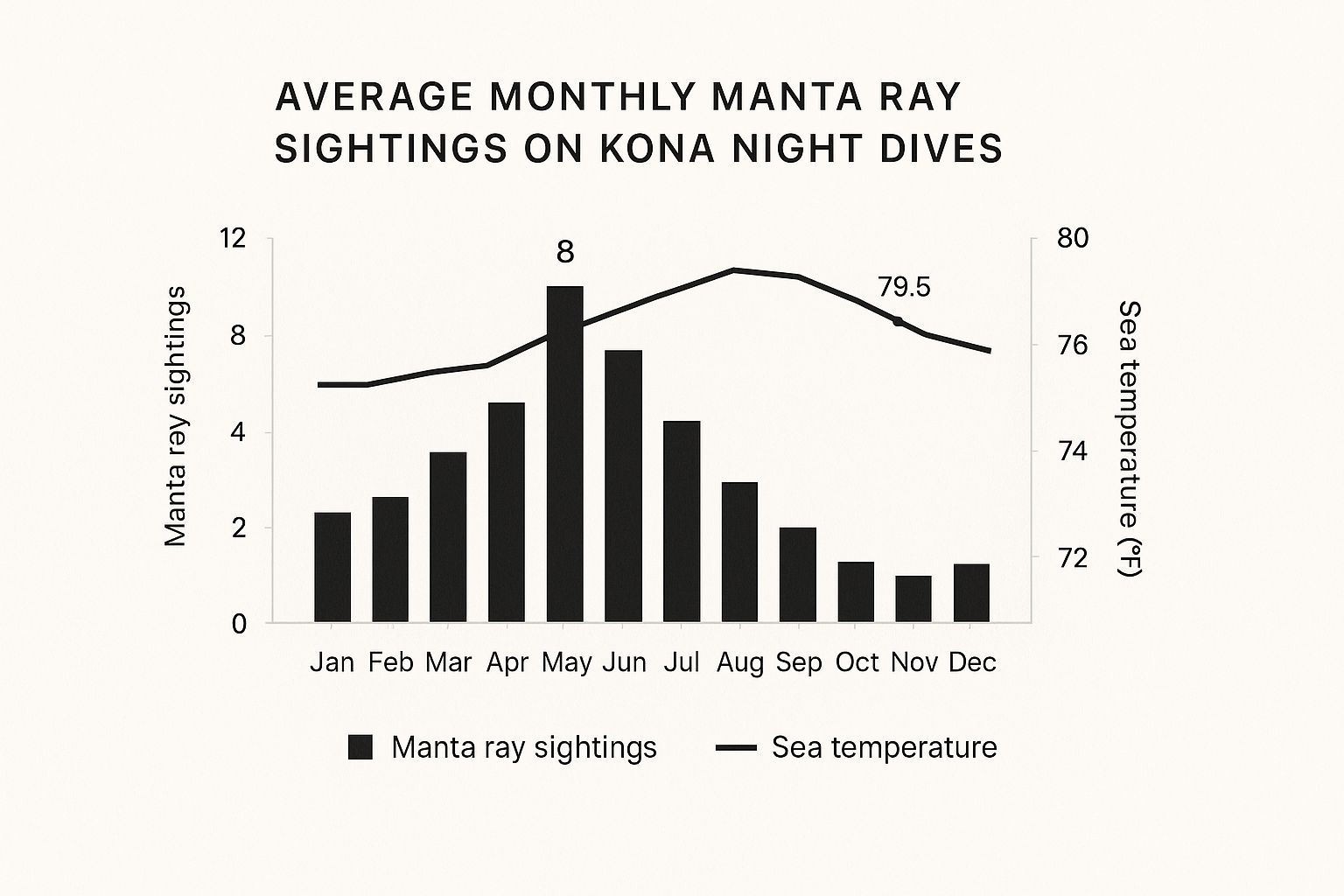Why Kona Delivers The World's Most Reliable Manta Encounters

Kona, Hawaii, isn't just a good place to dive with manta rays; it's widely regarded as the best place in the world. This isn't by chance. A unique convergence of factors creates a sanctuary for these gentle giants, providing divers and snorkelers an exceptional opportunity to witness them in their natural environment. Let's explore what makes Kona's manta ray encounters so remarkable.
The Volcanic Advantage
The Big Island's volcanic landscape is key. The sloping volcanic seabed forms channels and currents that bring nutrient-rich waters to the surface, carrying plankton, the manta rays' primary food source. Popular spots like Manta Village and Manta Heaven are perfectly situated near these volcanic slopes, creating natural feeding grounds.
These predictable feeding grounds, fueled by the consistent upwelling of plankton, draw manta rays to these specific locations. The volcanic rock formations also offer shelter and cleaning stations, further enhancing the area's appeal.
The abundance of food and suitable habitat contribute to a thriving manta ray population. The consistently clear, warm waters of Kona also provide excellent visibility, creating ideal conditions for observing these magnificent creatures.
A Feast of Plankton
This steady supply of food ensures the mantas have everything they need to flourish. The volcanic rocks also provide a place where smaller fish can clean parasites and dead skin from the mantas’ bodies – another important factor contributing to their well-being.
This combination of food, shelter, and cleaning stations makes Kona a true haven for manta rays. The consistently clear waters also contribute to an unforgettable viewing experience for divers and snorkelers alike.
High Sighting Success Rate
One of the most compelling reasons Kona is known for manta ray dives is the incredibly high sighting success rate. The Kona Coast boasts an 85-90% success rate for manta ray night dives year-round, making it a premier destination. Find more detailed statistics here.
This remarkable consistency solidifies Kona's reputation as a manta ray hotspot. Decades of conservation efforts have also been essential in protecting this unique ecosystem, ensuring future generations can experience the magic of Kona's manta rays.
Inside Kona's Extraordinary Manta Ray Community
Kona's resident manta ray population isn't just large; it's a flourishing community with complex social structures and behaviors. Decades of research have uncovered fascinating details about these gentle giants, from their individual personalities to their seasonal migrations. This means every manta ray dive in Kona offers a glimpse into a unique underwater society.
Unique Individuals, Unique Preferences
Just like us, individual manta rays develop their own personalities and preferences. Some are more curious and interact with divers, while others prefer to keep their distance. They even have favorite feeding spots, returning to these locations repeatedly. These preferences are partly shaped by Kona's distinctive underwater topography.
A Thriving Population
The Kona Coast boasts a thriving population of over 450 individual manta rays, frequently encountered during dives. Divers can typically expect to see about three manta rays per dive, with the highest number of sightings occurring during night dives. Discover more insights about manta ray populations. This impressive figure highlights the health and vitality of Kona's marine ecosystem. You might also be interested in learning What Is the Best Time of Year to See Manta Rays in Kona?
Tracking and Identification
Researchers employ advanced techniques, including photo-identification, to track and identify individual manta rays. The unique spot patterns on their ventral (belly) sides serve as natural fingerprints, enabling scientists to monitor individual movements and overall population trends. This data offers vital insights into ocean health and the success of ongoing conservation initiatives. For instance, changes in manta ray movement can indicate shifts in plankton distribution, reflecting broader oceanographic changes.
Indicator Species
The Kona manta ray population serves as a vital indicator species for marine conservation. Their health and behavior provide a window into the overall well-being of the ecosystem. Protecting manta rays, therefore, indirectly benefits the entire underwater community. Continued research and responsible tourism practices are crucial for ensuring the long-term survival of this remarkable community. You can learn more about the diving experience by reading What It’s Like to Go on the Manta Ray Dive in Kona, Hawaii.
Planning Your Perfect Manta Dive Kona Adventure
Transforming your manta ray dreams into a reality begins with careful planning. This ensures you'll maximize your chances of an unforgettable underwater encounter. Planning involves selecting the right operator, understanding seasonal nuances, and preparing for the conditions that create the most memorable experiences.
Choosing the Right Operator
Choosing a reputable manta dive operator is crucial for a positive experience. Look for operators with proven track records, a commitment to sustainable practices, and experienced guides. A good operator prioritizes both the safety of divers and the well-being of the manta rays.
They should provide thorough briefings on proper in-water etiquette and adhere to responsible interaction guidelines. This respect for the marine environment ensures a sustainable future for these gentle giants.
- Experience and Reviews: Research online reviews and seek recommendations from fellow divers.
- Group Size: Smaller groups often lead to more personalized and intimate encounters with the mantas.
- Equipment Quality: Ensure the operator provides well-maintained equipment, including wetsuits and dive lights.
- Sustainability: Choose operators committed to responsible tourism and manta ray conservation.
To help you choose, we've compiled a comparison of some popular Kona operators:
Kona Manta Dive Operators Comparison
This table compares top-rated dive operators in Kona, including their success rates, group sizes, equipment provided, and unique features.
| Operator Name | Success Rate | Max Group Size | Equipment Included | Special Features |
|---|---|---|---|---|
| Kona Honu Divers | 95% | 6 | Wetsuit, Dive Light | Underwater Photography, Manta Ray Education |
| Big Island Divers | 90% | 8 | Wetsuit, Dive Light, Fins | Night Snorkeling Tours |
| Manta Ray Dives of Hawaii | 98% | 10 | Wetsuit, Dive Light, Mask, Snorkel | Private Charters Available |
| Jack's Diving Locker | 92% | 12 | Wetsuit, Dive Light, BCD | Multi-Dive Packages |
Note: This is a sample table and the data might not reflect real-time information. Please contact individual operators for the most up-to-date details.
As you can see, there are many great options depending on your preferences and needs. Be sure to do your research to find the perfect fit for your adventure!
Understanding Seasonal Variations
While manta rays grace Kona's waters year-round, different seasons offer distinct advantages. Summer (April–October) generally boasts calmer waters and excellent visibility, creating ideal conditions for both snorkeling and diving.
Winter (November–March) can experience increased winds and rougher seas, potentially impacting tour availability. Understanding these seasonal variations allows you to plan accordingly and set realistic expectations. For solo travelers seeking extraordinary experiences, Kona's manta ray dives are highly recommended. You can explore more solo travel destinations for wildlife encounters.
Preparing for Your Dive
Preparation is key to maximizing your manta dive Kona experience. Beyond choosing an operator and considering seasonal factors, think about your personal needs. This includes preparing for the specific conditions of a night dive and ensuring you have the right equipment.
- Equipment Check: Double-check all your dive gear before your trip. If renting, confirm everything fits properly during the pre-dive briefing.
- Wetsuit: Even in warm Hawaiian waters, a wetsuit provides additional warmth, especially during night dives when you’re relatively inactive.
- Underwater Camera: Invest in a waterproof camera with low-light capabilities to capture the magic of the mantas. Practice using it beforehand.
- Seasickness: If prone to seasickness, take precautions such as medication or acupressure bands. Consult a doctor beforehand.
- Mental Preparation: Visualize the experience and practice slow, controlled breathing techniques.

Moon Phases and Weather Patterns
The moon phase and weather conditions can significantly influence manta ray activity. Reduced moonlight enhances plankton visibility, attracting mantas closer to the surface for feeding.
Check weather forecasts and consider the moon phase when scheduling your dive. These elements can significantly enhance your chances of a truly unforgettable encounter with these graceful creatures.
Mastering Night Diving For Unforgettable Manta Encounters
Night diving with manta rays in Kona offers a truly unique experience. However, it requires specific techniques to ensure both diver safety and the well-being of these gentle giants. Mastering these techniques can transform a good dive into an extraordinary one.
Understanding Manta Ray Behavior at Night
Manta rays are drawn to the lights used by dive operators at night. These lights attract plankton, the manta rays' primary food source. Understanding this behavior is the first step to positioning yourself for the best possible viewing. They often perform graceful, acrobatic movements while feeding, creating a captivating display for divers. Learn more in this article about How to master the manta ray night dive in the Big Island.
Light Positioning and Buoyancy Control
Proper light positioning is critical. Divers should point their lights upwards, towards the surface, creating a "plankton spotlight." This attracts the mantas and maximizes visibility without disrupting their natural feeding patterns. Maintaining neutral buoyancy is also essential. It prevents accidental contact with the mantas or the seabed, protecting the delicate marine environment and ensuring diver safety.
-
Stay Low: Position yourself near the seabed. This gives the manta rays ample space to move freely in the water column above.
-
Steady Beam: Keep your light beam steady to avoid sudden movements that may frighten the mantas.
-
Controlled Breathing: Practice slow, controlled breathing to conserve air and enhance buoyancy control.
Responsible Interaction Guidelines
Responsible interaction with manta rays involves respecting their space and minimizing any disturbance. Never try to touch or ride a manta ray. Their skin is covered with a protective mucus layer that can be harmed by human contact.
For additional information on enhancing your underwater experience, check out Manta Ray Kona Snorkel Adventures. Maintaining a respectful distance allows the mantas to feed naturally and undisturbed, ensuring a more authentic and rewarding encounter. Remember, divers are visitors in the mantas' world.
Emergency Protocols and Underwater Awareness
Being prepared for the unexpected is vital for any diver, especially at night. Familiarize yourself with emergency procedures, including essential hand signals and always knowing your dive buddy's location. Good underwater awareness helps you anticipate the mantas’ movements and adjust your position accordingly.
-
Buddy System: Stay close to your dive buddy and maintain regular visual contact.
-
Hand Signals: Review key dive hand signals before entering the water.
-
Emergency Ascent Procedures: Be familiar with the dive operator's emergency procedures and the location of any safety equipment.
This awareness not only improves your viewing experience but also contributes to the safety of everyone involved. By staying calm and observant during close encounters with these gentle giants, you can create truly unforgettable memories.
Conservation Success Stories And Ongoing Research
Kona's reputation as a premier manta ray diving destination isn't solely built on the incredible encounters it offers. It's also a testament to the diligent conservation work and ongoing research conducted in the area. These efforts have significantly reshaped our understanding of manta rays and provide a blueprint for sustainable wildlife tourism globally. Collaboration among scientists, dive operators, and even tourists is the cornerstone of this success.
The Power of Long-Term Studies
Dedicated scientists have invested years in studying Kona's manta rays. Their work has unveiled intricate details about manta ray behavior, migration patterns, and social structures. This long-term data is essential for understanding the needs of these gentle giants and for creating effective conservation plans. For instance, research has highlighted the importance of specific cleaning stations and feeding grounds, allowing for targeted protection of these critical habitats. Understanding their migratory routes also informs broader ocean management strategies.
Citizen Science: Tourists as Researchers
Citizen science plays a crucial role in manta ray research. Dive operators and tourists contribute valuable data to ongoing projects. This often involves photographing individual manta rays and uploading the images to research databases. The distinctive spot patterns on each manta's belly act like fingerprints, allowing researchers to track individuals over time and build a comprehensive picture of population dynamics. This collaborative approach empowers everyone to participate in scientific discovery.
Manta ray sightings in Kona have been meticulously documented for years, providing valuable insights into their behavior and habitat. From 2009 to 2014, underwater videographers conducted regular night dives at popular spots like 'Manta Village' and 'Manta Heaven'. More detailed statistics can be found here: Manta Ray Statistics.
Photo Identification and Tracking

Photo identification is a powerful research tool. Each manta ray possesses unique markings on its underside, much like a fingerprint. Researchers and citizen scientists photograph these markings to identify individual mantas. This makes it possible to track their movements, monitor the population size, and even study their social interactions. This data is fundamental for informing conservation strategies and safeguarding the future of these incredible animals.
Responsible Tourism: A Win-Win for Mantas and the Economy
Responsible tourism in Kona demonstrates that conservation and economic growth can be mutually beneficial. By choosing dive operators committed to sustainable practices, tourists directly support vital conservation initiatives, from habitat protection to population monitoring. This creates financial incentives for marine protection and ensures that manta ray diving experiences in Kona will be enjoyed by future generations. It also fosters a deeper appreciation for the marine environment and the importance of protecting these majestic creatures.
Choosing Between Manta Village And Manta Heaven
Kona, Hawaii, is a manta ray diver's paradise, offering two incredible locations: Manta Village and Manta Heaven. Both offer unforgettable encounters with these gentle giants, but each has unique characteristics that appeal to different divers. Choosing the right spot for your manta dive Kona adventure depends on understanding what makes each site special.
Manta Village: The Original
South of Kona, off the coast of Keauhou, lies Manta Village, the birthplace of night manta ray dives. Pioneering dive operators discovered the area's unique appeal: manta rays, drawn to the plankton illuminated by resort lights. Today, specialized dive lights recreate this effect, creating unforgettable close encounters. Manta Village is known for its calm waters, making it a great choice for newer divers or those susceptible to seasickness. The sandy bottom provides a stable platform for divers to observe the mesmerizing display above.
Manta Heaven: The Ballet of Giants
North of Kona, near the airport, is Manta Heaven, also known as Garden Eel Cove. While it has a slightly lower sighting rate than Manta Village (around 90% compared to 95+%), Manta Heaven is known for potentially larger groups of manta rays. Imagine witnessing multiple mantas performing their graceful feeding dances simultaneously—a truly breathtaking spectacle. However, this location can experience stronger currents, which may be challenging for less experienced divers. For a firsthand account, check out What It’s Like to Go on the Manta Ray Dive in Kona, Hawaii.
Key Differences and Considerations
Choosing the right dive site depends on your priorities and experience. The infographic below shows average monthly manta ray sightings and sea temperatures, highlighting peak season activity.

The infographic shows that while sightings are possible year-round, warmer months correlate with increased manta ray activity and comfortable water temperatures. Keep seasonal factors in mind when planning your manta dive Kona experience.
To help you compare Manta Village and Manta Heaven, we've created the following table:
Manta Village vs Manta Heaven Comparison: Detailed comparison of Kona's two premier manta ray dive sites, including depth, conditions, and unique characteristics.
| Feature | Manta Village | Manta Heaven | Best For |
|---|---|---|---|
| Location | South Kona (Keauhou) | North Kona (Airport) | |
| Depth | ~30-40 ft | ~30-40 ft | |
| Currents | Generally calm | Can be stronger | Beginner Divers |
| Sighting Rate | 95%+ | 90% | |
| Number of Mantas | Usually fewer (3-5) | Potentially more (5+) | Experienced Divers |
| Bottom Composition | Sandy | Sandy/rocky | |
| Experience Level | Beginner-friendly | More experienced divers |
Manta Village, with its calmer waters and high sighting rate, is ideal for beginners. Manta Heaven offers the chance to see larger groups of mantas but may be more challenging due to currents, making it better suited for experienced divers.
Both locations offer amazing opportunities for a memorable manta dive Kona experience. Remember, factors like weather and daily manta ray activity can influence site selection. Consulting with experienced dive operators, like Kona Honu Divers, is the best way to choose the right location for your needs and the prevailing conditions.
Maximizing Your Manta Dive Kona Experience
A manta dive in Kona, Hawaii isn't just another dive; it's an immersion into a truly special ecosystem. Turning this adventure into an unforgettable experience takes a bit of planning and some insider knowledge. Think about the ideal time to visit, how weather impacts the experience, and how best to prepare for encounters that will stay with you long after you’ve surfaced.
Timing Your Visit for Optimal Conditions
While you can find manta rays in Kona throughout the year, certain times offer better viewing opportunities. Summer (April–October) generally brings calmer seas and excellent visibility. This makes for a more comfortable dive, especially for those prone to seasickness. However, winter has its own unique advantages. Learn more in our article about What It’s Like to Go on the Manta Ray Dive in Kona, Hawaii.
Understanding Weather Patterns
Weather plays a key role in manta ray activity. Moonlight affects how visible the plankton is, and plankton is crucial for attracting mantas. Checking weather forecasts and understanding the lunar cycle can greatly improve your viewing experience. For example, a new moon creates darker conditions, making the plankton illuminated by dive lights even more alluring to the mantas.
Preparing for Unforgettable Encounters
Preparation is essential for maximizing any dive. This includes having the right gear, understanding proper dive etiquette, and being prepared for potential challenges like seasickness. A well-fitting wetsuit, an underwater camera with settings for low light, and seasickness remedies are all important for a positive experience.
Beyond the Manta Dive: Complementary Activities
Kona offers a wealth of activities to complement your manta ray dive. Exploring lava tubes, discovering vibrant coral reefs during the day, or even taking a volcano tour can add another dimension to your Big Island adventure. This lets you experience the diversity of the island, both above and below the surface.
Extending Your Underwater Adventure
Extend the wonder of your underwater journey. Think about booking multiple dives, exploring certification opportunities if you're not already certified, or even participating in volunteer programs that support marine conservation efforts. These opportunities offer unique ways to connect with the ocean environment and help protect it.
Capturing Memories and Connecting With the Community
Don’t forget to document your manta ray dive! Invest in a good underwater camera and practice with it before your trip. Sharing your experience with the local diving community can also enhance your appreciation for Kona's underwater world. Consider joining online forums or connecting with local dive clubs to swap stories and learn from experienced divers. This can lead to new friendships and offer valuable insights for future dive trips. Planning a return trip to further your connection with these amazing creatures and their ocean home is a testament to the wonder of a truly special dive experience.
Ready for your own unforgettable manta ray adventure? Book your dive with Kona Honu Divers today! Dive into the magic.
